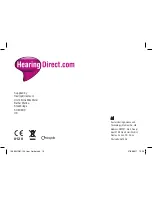
12
13
Moisture build up is a common cause of hearing aid failure and
preventing it from occurring will help extend the life of the hearing aid.
We recommend placing hearing aids into a ‘dry-aid kit’ or dehumidifier
overnight which will help draw moisture out of the instruments
overnight. A selection of dry aid kits are available on our website.
Please do not wear the hearing aid when swimming. Remove the
hearing aid when it is raining, and when showering or bathing. If
hearing aid accidentally falls into the water, do not use a hairdryer or
microwave to dry it. You can dry it with a soft, clean cotton cloth and
put it in a ventilated environment, or in a dry aid kit for a few days.
Do not expose the hearing aid to extreme temperatures or allow
prolonged exposure to sunlight.
Do not drop your hearing aids or knock them against hard surfaces.
Precautions
for hearing aid
The product’s maximum output sound pressure level is under the product
software control, which ensures the end user cannot be exposed to sound
pressure levels higher than 132 dB, even in the event of device failure.
Do not wear your hearing aids during X-ray, MR scans, CT scans,
short-wave diathermy, or similar radiation treatments.
Please take off your hearing aids before you go into high electrical
fields or strong magnetic fields and leave your hearing aids outside.
(Such as transformer substation or power stations).
Precautions
for hearing aid
10889 HD91-150 User Guide.indd 12-13
27/09/2017 12:36



















